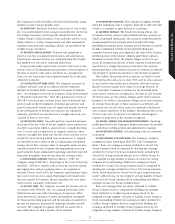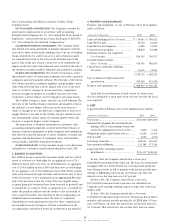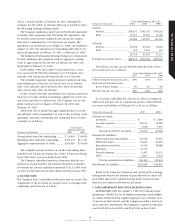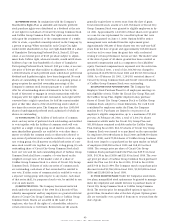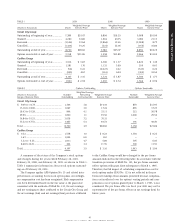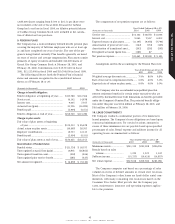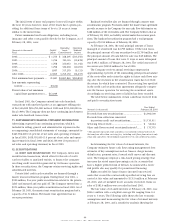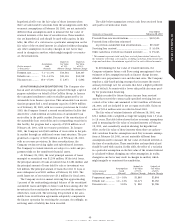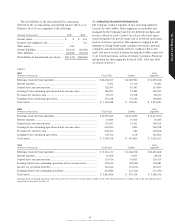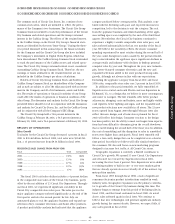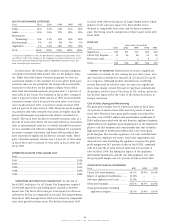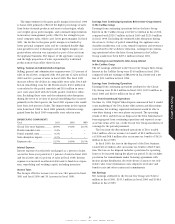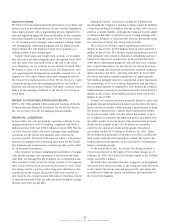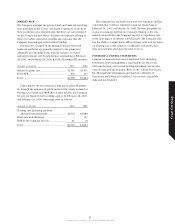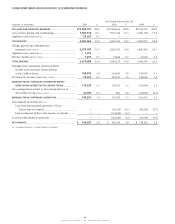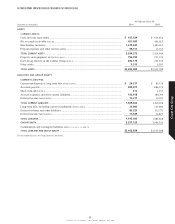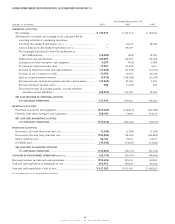CarMax 2001 Annual Report Download - page 49
Download and view the complete annual report
Please find page 49 of the 2001 CarMax annual report below. You can navigate through the pages in the report by either clicking on the pages listed below, or by using the keyword search tool below to find specific information within the annual report.
13. INTEREST RATE SWAPS
The Company enters into amortizing swaps relating to automobile
loan receivable securitizations to convert variable-rate financing
costs to fixed-rate obligations to better match funding costs to the
receivables being securitized. The Company entered into nine 40-
month amortizing swaps with notional amounts totaling approxi-
mately $735 million in fiscal 2001, four 40-month amortizing
swaps with notional amounts totaling approximately $344 million
in fiscal 2000 and four 40-month amortizing swaps with notional
amounts totaling approximately $387 million in fiscal 1999. These
swaps were entered into as part of sales of receivables and are
included in the gain or loss on sales of receivables. The remaining
total notional amount of all swaps related to the automobile loan
receivable securitizations was approximately $299 million at
February 28, 2001, $327 million at February 29, 2000, and $499
million at February 28, 1999. The reduction in the total notional
amount of the CarMax interest rate swaps in fiscal 2001 and in fis-
cal 2000 relates to the replacement of floating-rate securitizations
with a $655 million fixed-rate securitization in January 2001 and a
$644 million fixed-rate securitization in October 1999.
The market and credit risks associated with interest rate
swaps are similar to those relating to other types of financial
instruments. Market risk is the exposure created by potential
fluctuations in interest rates and is directly related to the product
type, agreement terms and transaction volume. The Company
does not anticipate significant market risk from swaps, because
their use is to more closely match funding costs to the use of the
funding. Credit risk is the exposure to nonperformance of
another party to an agreement. The Company mitigates credit
risk by dealing with highly rated counterparties.
14. CONTINGENT LIABILITIES
In the normal course of business, the Company is involved in var-
ious legal proceedings. Based upon the Company’s evaluation of
the information presently available, management believes that the
ultimate resolution of any such proceedings will not have a mate-
rial adverse effect on the Company’s financial position, liquidity
or results of operations.
15. APPLIANCE EXIT COSTS
On July 25, 2000, the Company announced plans to exit the
major appliance category to expand its selection of key con-
sumer electronics and home office products in all Circuit City
Superstores. This decision reflected significant sales weakness
and increased competition in the major appliance category and
management’s earnings expectations for these other products. To
exit the appliance business, the Company closed six distribution
centers and seven service centers in fiscal 2001 and expects to
close two distribution centers and one service center by July 31,
2001. The majority of these properties are leased. The Company
is in the process of marketing these properties to be subleased.
Circuit City maintains control over its in-home major appliance
repair business, although repairs are subcontracted to an unre-
lated third party. In the second quarter of fiscal 2001, the
Company recorded appliance exit costs of $30 million. Most of
these expenses are included in cost of sales, buying and ware-
housing on the statement of earnings for fiscal 2001. There were
no adjustments to the exit costs as of February 28, 2001.
Approximately 850 employees have been terminated and
approximately 100 employees will be terminated as locations
close or consolidate. These reductions were mainly in the service,
distribution and merchandising functions. Because severance is
being paid to employees on a bi-weekly schedule based on years
of service, cash payments lag job eliminations. The exit costs
also include $17.8 million for lease termination costs and $5.0
million, net of salvage value, for the write-down of fixed assets.
Expenses
Paid or Liability at
Total Assets February 28,
(Amounts in millions) Exit Costs Written Off 2001
Lease termination costs ................. $17.8 $ 1.8 $16.0
Fixed asset write-downs................ 5.0 5.0 —
Employee termination benefits..... 4.4 2.2 2.2
Other ................................................. 2.8 2.8 —
Appliance exit costs....................... $30.0 $11.8 $18.2
16. DISCONTINUED OPERATIONS
On June 16, 1999, Digital Video Express announced that it
would cease marketing the Divx home video system and discon-
tinue operations, but that existing, registered customers would
be able to view discs during a two-year phase-out period. The
operating results of Divx and the loss on disposal of the Divx
business have been segregated from continuing operations and
reported as separate line items, after taxes, on the consolidated
statements of earnings for the periods presented. Discontinued
operations also have been segregated on the consolidated state-
ments of cash flows for the periods presented. However, Divx is
not segregated on the consolidated balance sheets.
For fiscal 2001, the discontinued Divx operations had no
impact on the net earnings of Circuit City Stores, Inc. The loss
from the discontinued Divx operations totaled $16.2 million
after an income tax benefit of $9.9 million in fiscal 2000 and
$68.5 million after an income tax benefit of $42.0 million in fis-
cal 1999. The loss on the disposal of the Divx business totaled
$114.0 million after an income tax benefit of $69.9 million in
fiscal 2000. The loss on the disposal includes a provision for
operating losses to be incurred during the phase-out period. It
also includes provisions for commitments under licensing agree-
ments with motion picture distributors, the write-down of assets
to net realizable value, lease termination costs, employee sever-
ance and benefit costs and other contractual commitments.
46
CIRCUIT CITY STORES, INC. 2001 ANNUAL REPORT



